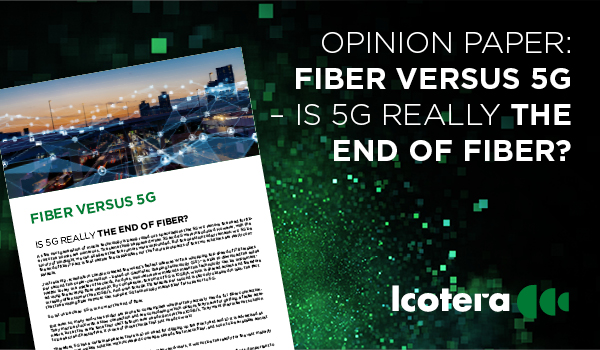The tri-band router is said to be a smart way to create wireless backhaul for extenders in a Wi-Fi network. But is it really a way forward for European households? Or is it just marketing hype?
The majority of Wi-Fi routers are dual-band, but there is a new router being marketed as a smarter solution,
especially when it comes to accommodating wireless backhaul for extenders: the tri-band router.
Put simply, where dual-band consists of two bands (2.4 GHz and 5 GHz), tri-band Wi-Fi routers claim to
provide three wireless bands. The problem with tri-band routers, however, is that to obtain the additional
band, the most important band – 5 GHz – is being split in two, meaning that you end up with one 2.4 GHz and
two "half" 5 GHz bands, each with limited frequency bands available.
But will tri-band improve in-home performance?
The short answer is no. At least not yet, if you live in Europe.
In this quick-read, we will look at the three main reasons why tri-band routers are not suitable for European
households.
1. No guarantee of better speed
When using tri-band routers, the two 5 GHz radios will most likely overlap and interfere with each other,
unless filters are applied.
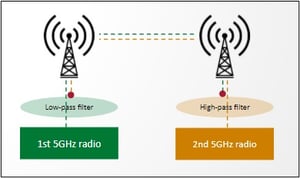
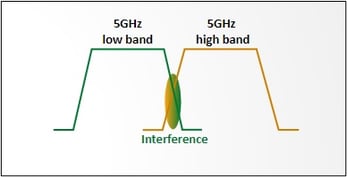
To avoid that the transmitting TX signal leaks into another radio, low-pass filters and high-pass filters are implemented. Unfortunately, these filters are both costly and cut off up to 2 dB of the power – which is approximately 30 percent. This means that when the power is turned up to compensate for the filter loss, the noise is being amplified, and the signal-to-noise ratio goes down. And this, because of nonlinearity, results in low signal quality for the end-user.
2. Nowhere to move the channel
When using low- and high-pass filters, another challenge arises.
Since each antenna is equipped with a band-pass filter, the 5 GHz band is divided into two "half-bands" – meaning that only two 80 MHz channels are available in each of the half-bands. And, in the European 5 GHz band, three out of these four 80 MHz channels are subject to dynamic frequency selection (DFS), which means the risk of frequently being forced to leave the DFS channel due to radar detections will be high.
When such a DFS disturbance occurs on an 80 MHz channel, the Wi-Fi management system has only one place to move the channel, which might not be optimal due to other users in the neighborhood – or worst case, radar detection on the alternate channel as well.
Worst case, this means that the disturbed antenna will be locked and thus unusable for up to 30 minutes during the mandatory channel availability check (CAC).
By comparison, the dual-band solutions are free to choose among any of the three remaining channels and will always have the only non-DFS channel available, since no band-pass filters are applied. Some chipset manufacturers even perform a constant CAC in the background, which means that the router will know in advance where to go if radar signals are detected.
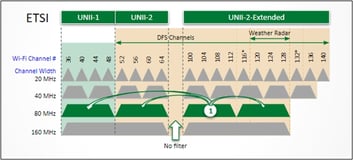
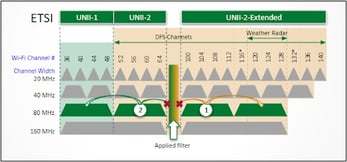
3. Densely populated means lower throughput
When deploying Wi-Fi in densely populated areas, it's crucial to have channel flexibility so that neighboring routers can use different channels in order to avoid interference and save airtime.
But when there are only two channels to choose from, it becomes difficult to find a channel that is not being used by a neighboring router. This is especially a problem in apartment buildings, where you have neighbors on all sides.
Result: The tri-band solution's fewer channel selection options creates a greater risk of co-channel interference.
The consequence is to accept a lower throughput and thereby weaken the user experience.
Why tri-band routers are still being developed
One question naturally springs to mind: If there are so many disadvantages associated with a tri-band solution, why is the technology still being adopted by many operators, especially in the US?
According to the regulations of the Federal Communications Commission in the US, there must be additional channels available in the upper end of the 5 GHz band – and these channels provide greater flexibility to US operators than their European counterparts. Tri-band solutions could also have their advantages in the countryside, where nearby neighbors are not a problem, but once again, only if DFS interruptions are unlikely.
To sum up: The tri-band solution is feasible in the US and in sparsely populated areas outside the US, but due to the lack of channel flexibility in Europe, interference is causing major challenges, and most of the large operators in Europe consider tri-band to be a non-viable solution.
In the future, with Wi-Fi 6E, it is likely that true tri-band routers will make good sense in Europe, because Wi-Fi 6E routers will cover 2.4 GHz, 5 GHz and 6 GHz – three separate and non-overlapping bands with many channels available and, best of all, no DFS limitations on the 6 GHz band.
Want to know more?
Feel free to contact our Technical Program Manager, Jens Bundgaard,
at jbu@icotera.co for a chat about tri-band versus dual-band.
--------------------------------------------------------------------------------
WANT TO KNOW MORE about why the issue of 5G and fiber isn’t a question of either/or?
Download our opinion paper Fiber versus 5G - is 5G really the end of fiber here

